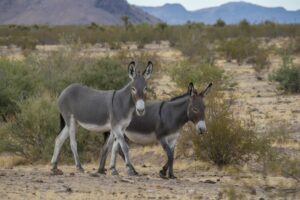Hoof Prints & Habitats

Managing Arizona’s Wild Burro Population
Writer Joseph J. Airdo // Photography Courtesy of the Bureau of Land Management’s Arizona State Office



The sight is becoming increasingly familiar to North Valley residents: Wild burros wandering through neighborhoods, grazing on manicured lawns and occasionally wandering into roadways. While these federally protected animals have long been iconic symbols of the American Southwest, their increasing presence in residential areas presents complex challenges for natural resource managers, residents and the burros themselves.
“There are many factors contributing to burros migrating into communities,” explains Dolores A. Garcia, public affairs specialist for the Bureau of Land Management’s Arizona State Office. “One is the ever-expanding community boundaries or urban sprawl. Another primary factor is drought conditions, which limit the availability of water and food sources in the desert.”
Garcia notes that overpopulation compounds these issues, creating increased competition for already limited resources.
“As a result, burros move into areas where resources are more abundant, such as communities with lush green landscapes,” she says.
The Bureau of Land Management is tasked with maintaining these wild burro populations in accordance with the Wild and Free-Roaming Horse and Burro Act of 1971, which requires the agency to manage burros in “a thriving natural ecological balance” with their environment. This mandate creates a delicate balancing act between conservation requirements, animal welfare concerns and public safety.
When burros venture into developed areas, they create potential hazards for motorists and face dangers themselves. These situations require strategic intervention.
“The BLM addresses overpopulation issues and concerns for both public and burro safety by coordinating gathers,” Garcia explains. “All BLM gather operations must follow our comprehensive animal welfare standards to ensure animal health and safety throughout the process.”
The agency planned a gather for mid-April 2025 in north Phoenix, including the New River and Anthem communities, with a goal of collecting 400 burros. As of this issue’s press deadline, the operation had not yet concluded. The BLM uses the bait trap method, which involves placing small, temporary pens with food and water as bait. When burros enter, gates automatically close behind them.
“After collection, the animals are transported to our off-range corrals and holding facility in Florence, where they receive veterinary examinations before entering our private care and placement program,” Garcia says. “BLM Arizona has achieved a 100% success rate in placing all burros gathered from the range into private care.”
The agency doesn’t work alone in these efforts. Private organizations play a crucial role in the broader management strategy.
“The BLM recognizes and appreciates the efforts of private organizations that support wild horse and burro adoptions, training and education,” Garcia notes. “These organizations help save taxpayer funds by reducing the costs associated with caring for unadopted wild horses and burros.”
Those cost savings are significant. Based on 2024 figures, it costs approximately $15,000 to care for a single wild horse or burro in BLM facilities over its lifetime if it is not placed into private care.
Looking ahead, the BLM is developing a comprehensive population control plan for larger-scale gathers to address the broader overpopulation issue within the Lake Pleasant Herd Management Area. The agency is also taking proactive measures to prevent dangerous encounters between burros and vehicles.
“We’re collaborating with partners like the Arizona Department of Transportation and local municipalities to improve fencing that keeps burros away from busy roadways and to increase signage alerting drivers about potential burro crossings,” Garcia says.
For residents encountering wild burros, safety should be the primary concern. These undomesticated animals, while appearing docile, can be dangerous. Experts advise maintaining a respectful distance, never feeding them and reporting their presence to the appropriate authorities rather than attempting to handle them personally.
With thoughtful management and community cooperation, both Arizona’s wild burros and its human residents can safely coexist in this shared desert landscape.

